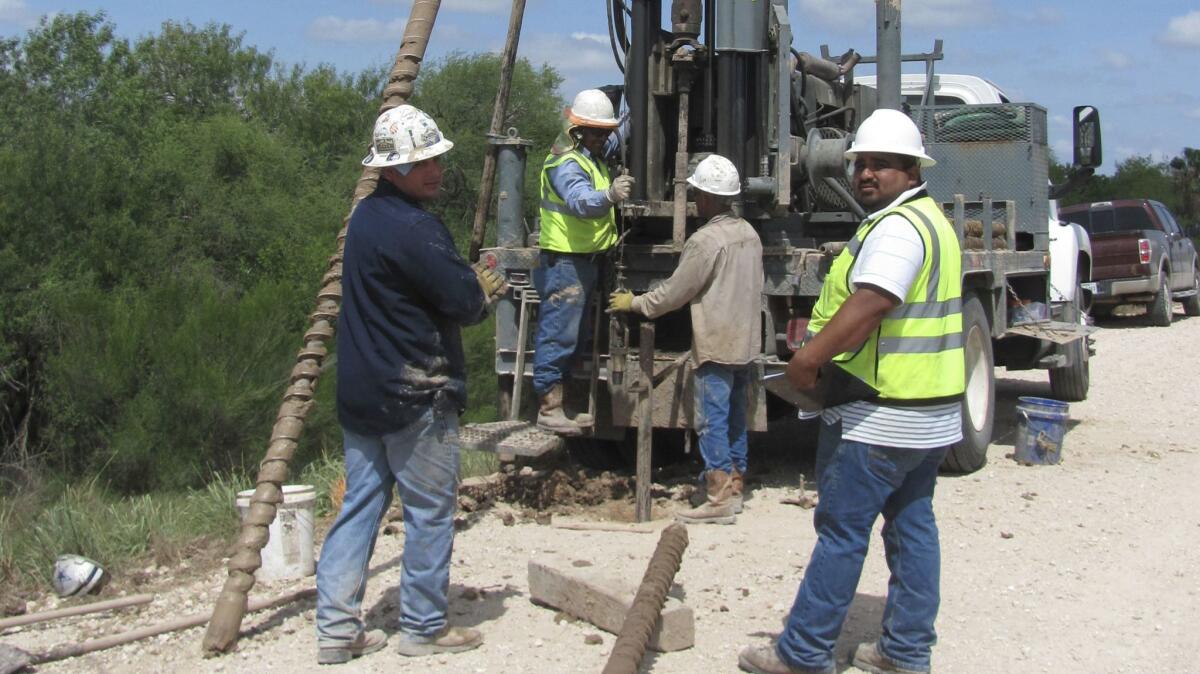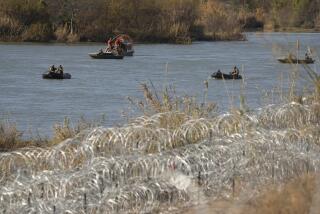This ‘crown jewel’ of wildlife refuges is one of the world’s top bird destinations. Trump’s wall would end public access

Environmentalists along the U.S.-Mexico border are gearing up for a fight as federal officials zero in on the Santa Ana National Wildlife Refuge in Texas to build the first stretch of the border wall promised by President Trump.
Last week, the U.S. Army Corps of Engineers used a drilling rig to extract soil samples at the Rio Grande Valley refuge to prepare for the possibility of constructing three miles of concrete levee wall and fence, according to a federal Homeland Security official who spoke on the condition of anonymity to describe internal planning for the wall.
There is no money in the current federal budget for wall construction on the site. But federal engineers are preparing on the basis that Congress could approve funding for the 2018 budget year, the official said.
The 2,088-acre refuge about 10 miles southeast of McAllen in the southern tip of Texas was created by the federal government in 1943 for the protection of migratory birds and is managed by the U.S. Fish and Wildlife Service. Straddling a bend in the Rio Grande, it is home to the endangered ocelot, as well as jaguarundi, coyote, bobcats, armadillos and 400 bird species, making it one of the top birding destinations in the world.
The proposed barrier there, first reported by the Texas Observer, would cut off the refuge from its visitor’s center and the rest of the country. Environmental advocates say that could have a devastating effect on the animals who live in or roam the refuge and to the residents of one of Texas’ poorest regions who depend on the tourism it draws.
“This is insane,” said Scott Nicol, co-chairman of the Borderlands Team for the Sierra Club. “This is the crown jewel of the Rio Grande Valley wildlife refuge system, with one of the highest rates of biodiversity in the U.S. If it’s walled off, with no public access, it will be left to rot. Ocelots could be pushed over the cliff and into extinction in the United States.”
But federal officials say that building a wall would allow them to ramp up immigration and drug-smuggling enforcement in the Rio Grande Valley, one of the most heavily trafficked portions of the border — with many places lacking any barrier.
“The Rio Grande Valley area has been an area of exploitation by smugglers, and an area lacking in border infrastructure,” Carlos Diaz, a Customs and Border Protection spokesman, wrote in an email. “These miles will help connect existing segments of wall throughout the area and fill critical gaps.”
Under the requested 2018 budget, Customs and Border Protection has prioritized 28 miles of new levee wall system in the Rio Grande Valley, Diaz said. The agency has already held preliminary meetings for projects under the enacted 2017 budget as well as those it hopes to fund in the next budget.
The U.S. Army Corps of Engineers is under contract with Michael Baker International, a global engineering firm, to gather geotechnical data at sites in the Rio Grande Valley and other locations along the Southwest border, according to Jenny Burke, a spokeswoman for the Homeland Security Department.
On Monday, U.S. Rep. Filemon Vela, a Democrat from Brownsville who represents the area of the border including Santa Ana, said he requested a briefing about the wall from Customs and Border Protection officials.
“Clearly, it’s all being done in secret and it’s not transparent at all,” he said. “I can tell you we’re going to fight like hell to stop it.”
“These refuges are national treasures and sacred places, and we have to do everything we can to stop the Trump administration from putting this wall into place,” said Vela, who opposes all border walls in his district, famously telling Trump in an open letter last year: “Mr. Trump, you’re a racist and you can take your border wall and shove it up your ass.”
Estimates for a continuous wall along the southern border have ranged from $12 billion to $20 billion. Trump told reporters aboard Air Force One last week that his wall would not have to cover the entire 2,000-mile border because parts were blocked by mountains and rivers. About 600 miles already have walls, fences or other barriers.
Over the last decade, the government has erected about 56 miles of fencing in the Rio Grande Valley, mostly atop levees on land the government seized through eminent domain.
Unlike much of the land the government wants to build on in south Texas, the wildlife reserve is already federally owned and will not involve the costly process of trying to seize property.
But building along the Rio Grande presents a range of engineering and other challenges, including a 1970 treaty with Mexico that could restrict construction in the floodplain.
Environmentalists are especially worried that a barrier along the levees would put animals in danger by trapping them during floods.
“Essentially, you’re creating an impassable barrier, so wildlife cannot get to the river or away from the river,” said Jim Chapman, vice president of the Friends of the Wildlife Corridor, a nonprofit group that advocates for the valley’s native habitat.
In 2010, the Santa Ana refuge was flooded by high waters that resulted from Hurricane Alex. Many plants and animals did not survive, and environmental advocates say the impact would only be more devastating if a border wall was in place.
“Santa Ana was underwater for four months,” Nicol said. “A terrestrial animal can’t tread water for four months.”
A wall would also have a negative economic effect across the region, opponents say. The Santa Ana refuge is home to 165,000 visitors a year, many birders from across the world. A 2011 study by Texas A&M University found that nature tourism in the Rio Grande Valley brought in $463 million a year. The biggest portion of that is from birding.
Special correspondent Jarvie reported from Atlanta and Times staff writer Bennett from Washington.
ALSO
A California businessman born in former Soviet Union also attended Trump Jr. meeting
House Republicans unveil budget blueprint that boosts military spending and favors Medicare cuts
UPDATES:
July 18, 11:58 a.m.: The article was updated to reflect that news of the refuge as a possible site for the wall was first reported by the Texas Observer.
This article was originally published July 17 at 7:45 p.m.
More to Read
Start your day right
Sign up for Essential California for news, features and recommendations from the L.A. Times and beyond in your inbox six days a week.
You may occasionally receive promotional content from the Los Angeles Times.







